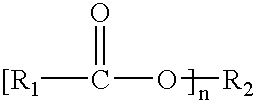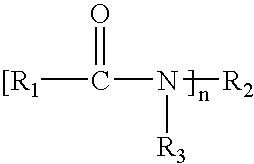Concentrated fabric softener active compositions
a technology of active compositions and fabric softeners, applied in the field of fabric care compositions, can solve the problems of large capital investment required for fabric softeners, inconvenient use of conventional rinse-added fabric softeners, and inability to meet the needs of use,
- Summary
- Abstract
- Description
- Claims
- Application Information
AI Technical Summary
Benefits of technology
Problems solved by technology
Method used
Image
Examples
example 1
An Example of a CFSC is Prepared
[0098] Esteramine T7: To a 5 L flask is added T7 Fatty Acid (2891.3 g, 10.51 mol) and phosphorous acid (3.92 g, 0.05 mol). Stirring is initiated and methyldiethanolamine (835.3 g, 7.01 mol) is added under nitrogen sweep. Mixture is heated to 190° C. and water is removed via distillation. Upon reaching the free fatty acid target of 0.35 meq / g, vacuum is applied to −600 mmHg. Reaction conditions are held until target final acidity (0.055 meq / g) is reached to produce esteramine T7.
[0099] To a 4 L glass pressure-rated vessel is added Esteramine T7 (1796.8 g, 3.50 mol) with stirring. Hard Tallow (175.03 g), Stepan GMS pure (16.40 g) and glycerine, 99% (30.21 g) are added. The reactor is sealed, inerted with nitrogen and heated to 105° C. Methyl chloride (175.40 g, 3.47 mol) is added at a rate to maintain 40 psig pressure. Upon reaching the free amine target (0.06 meq / g), the reactor is inserted with nitrogen.
[0100] The product is flaked by placing the m...
example 2
Single Rinse Fabric Care Compositions are Provided
[0101]
EXAMPLESINGREDIENTSABCDEFFSAa6.5%4.875%6.5%7.25%7.5%5%FSAb0%1.625%0%0%0%0%Diluentc0.4-1.5%0.4-1.5%0.4-1.5%0.4-1.5%0.4-1.5%0.4-1.5%Monoglycerol Stearate0.2-1%0.2-1%0.2-1%0.2-1%0.2-1%0.2-1%Glycerine0-1%0-1%0-1%0-1%0-1%0-1%Suds Suppressord0.1%0.1%0.1%0.1%0.13%0.1%Cationic Starche0%0%0.7%0%0%1.0%Perfume0.8-1.5%0%0.8-1.5%0.8-1.5%0.8-1.5%0.8-1.5%Rheology Modifierf0%0%0%0%0%0.2%Calcium Chloride0.1-0.15%0.1-0.15%0.1-0.15%0.1-0.15%0.1-0.15%0.1%Preservativeg0.025%0.025%0.025%0.025%0.0125%0.025%Dye0.003%-0.03%0.003%-0.03%0.003%-0.03%0.003%-0.03%0.003%-0.03%0.003%-0.03%Hydrochloric Acid0.025%0.023%0.025%0.025%0.021%0.020%Deionized WaterBalanceBalanceBalanceBalanceBalanceBalance
aReaction product of Fatty acid with Methyldiethanolamine in a molar ratio 1.5:1, quaternized with Methylchloride, resulting in a 1:1 molar mixture of N,N-bis(stearoyl-oxy-ethyl) N,N-dimethyl ammonium chloride and N-(stearoyl-oxy-ethyl) N,-hydroxyethyl N,N dimethyl ...
example 3
Fabric Care Composition is Made from a Solid CFSC
[0104] A solid CFSC is grinded to a small particle (e.g 3). The fabric care composition is made by adding the ground CFSC to a beaker containing 80° C. deionized water, HCl and CaCl2 with stirring. The mixer is stirred for 10 minutes. Perfume and dye are then added and mixture is cooled in an ice bath to 25° C.
PUM
| Property | Measurement | Unit |
|---|---|---|
| temperature | aaaaa | aaaaa |
| viscosity | aaaaa | aaaaa |
| viscosity | aaaaa | aaaaa |
Abstract
Description
Claims
Application Information
 Login to View More
Login to View More - R&D
- Intellectual Property
- Life Sciences
- Materials
- Tech Scout
- Unparalleled Data Quality
- Higher Quality Content
- 60% Fewer Hallucinations
Browse by: Latest US Patents, China's latest patents, Technical Efficacy Thesaurus, Application Domain, Technology Topic, Popular Technical Reports.
© 2025 PatSnap. All rights reserved.Legal|Privacy policy|Modern Slavery Act Transparency Statement|Sitemap|About US| Contact US: help@patsnap.com



